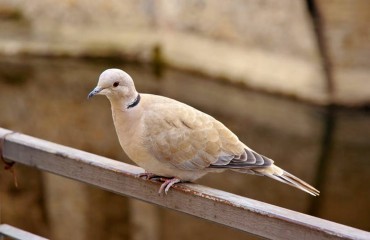
Eurasian collared-doves are setting some kind of a record when it comes to colonizing North America. They aren’t native to this continent but their numbers stretch from coast to coast.
This bird is a native of Europe and parts of Asia. After being introduced to this continent in recent years, their numbers exploded. They are still exploding.
Many people on the Kitsap Peninsula are seeing them for the first time. When they try to identify this new bird, one common question arises: “Turtle doves aren’t supposed to be seen around here, are they?”
There are no ringed turtle doves in the Pacific Northwest but the Eurasian collared-doves are related to them. Both species belong to the genus Streptopelia. Along with the spotted dove, all three of these “cousins” have been introduced to North America.
Both the turtle doves and the spotted doves limited their territorial expansion to the Southwest. The collared-dove shows signs of planning to conquer the world. Now is the time to learn to identify this mystery bird, as your yard may be next.
They are much larger than the dainty turtle dove. The “collar” on the back of their neck is more pronounced. This bird’s best field mark or identification characteristic is the band on its tail. It is about 2 inches long and is pure white. As the collared-dove is a pale gray-tan, the white band stands out. Whether the bird is perched or flying, it will catch your eye.
Like other doves and pigeons, it is a ground feeder and content to search for the spillage found under most feeders. However, these large doves do land on platform feeders and hustle the smaller birds aside. They’re not overly aggressive — just bigger than the other birds.
The fact that a number of West Sound residents are seeing this bird for the first time points to their growing numbers.
In recent years, they have been seen all over the area but in isolated places. As their offspring increase and mature, they need their own territory. Numbers continue to spread and more people become familiar with this dove and its vocal abilities.
The sound of “roo-coo-coo” or “coo-coo-cook” announces the Eurasian collared-dove’s arrival to the neighborhood. Throughout the mating and nesting season, from early morning to late afternoon and evening, the calls go on and on.
This soft, almost mournful, call isn’t the only sound the birds make. During courtship, the male hopes to attract a mate with a harsh, nasal “krreew.” It’s a little scary and hair-raising. It also signals to any other males in the vicinity that they aren’t welcome.
It will be interesting to note the changes that will occur as this bird’s population numbers continue to grow. Hopefully, it won’t become a pest like the rock pigeon (formerly rock dove). As it moves into new territories, will the two co-exist or not?
So far, they do not appear willing to socialize with one another. The collared-doves seem to avoid the rock doves.
One point is clear: If you haven’t seen or heard Eurasian collared-doves in your neighborhood, you will. Native or not, they’ve moved in and all signs point to rapid population growth.























Comments